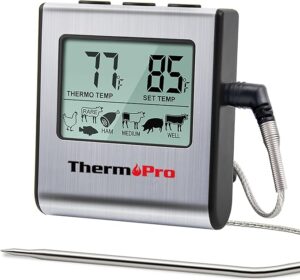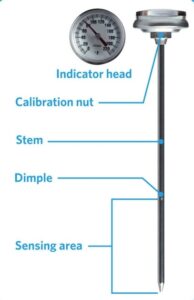

Calibrating Food Thermometers: Did You Know?
The most important piece of food safety equipment is the probe thermometer. It will be essential to prove your compliance with the most common food safety risk factor: time and temperature control. It can cause more problems, however, if it is not calibrated properly and frequently. Here are some things to remember:
(1) Choose the correct thermometer for the job. Use a bimetallic or digital thermometer for checking food temperatures. They must have a range of 0-220 degrees Fahrenheit with a measurement error of no more than ±2 degrees Fahrenheit.
An Infrared Thermometer is a good survey device for checking surface temperatures of hard-to-reach spaces or checking hot and cold spots in a refrigerator. It only measures surface temperatures, however, and will not check the internal temperatures of food.
Oven thermometers can be used to monitor the cooking process; the more advanced models are digital and will sound an alarm when the proper temperature is reached. While their accuracy has improved over the traditional meat thermometer, always verify the final food temperature using a calibrated probe thermometer.
Thermocouples are more expensive than bi-metallics but they have distinct advantages. They read temperatures more rapidly along the entire length of their stem. Bi-metalllic thermometers only read temperatures at the dimple in their stem, so they cannot accurately read the temperature of a thin piece of food.
(2) Calibration Methods: the two methods are boiling point and freezing point.
Boiling Point: Immerse the thermometer dimple or stem in 212 degrees Fahrenheit (boiling) water and calibrate the thermometer to 212 degrees Fahrenheit. You must adjust the process based on the altitude above sea level. For instance, Detroit is 620 feet while New York City is 26 feet (approximate figures). While at sea level, 212 degrees Fahrenheit will be an accurate calibration, as the altitude increases, the calibration decreases.
• Sea Level: 212°F (100°C)
• 1,000 feet: 210°F (98.9°C)
• 2,000 feet: 208°F (97.8°C)
• 3,000 feet: 206.4°F (96.9°C)
• 4,000 feet: 204.5°F (95.8°C)
• 5,000 feet: 202.75°F (94.9°C)
• 8,000 feet: 197.5°F (91.9°C)
Freezing Point: Use a container large enough to accommodate the thermometer. Fill it with crushed ice and water to make a slurry. Submerge the thermometer, letting the reading stabilize; calibrate to 32 degrees Fahrenheit.
Common Calibration Problems: While most food service operators use only the freezing point calibration method, the boiling point method adds accuracy which should not be ignored, especially where your menu includes many cooked foods.
Be certain the thermometer is cleaned and sanitized; any soil will affect the calibration. Do not allow the thermometer to touch the sides or bottom of the container. Water with hardness or minerals will also affect the reading, raising or lowering the freezing and boiling points. If possible, use distilled water (bottled water). Finally, invest in at least one digital thermometer or thermocouple to verify your calibration.
Always important: Keep track of your calibrations. Document what you’ve done, both to satisfy future audits as well as to identify any patterns of problems you can correct early.
‘Thermometer Calibration: How to Calibrate a Thermometer with Ice and Boiling Water’
Katrin Liivat – FoodDocs CEO Feb 19, 2025 https://www.fooddocs.com/post/thermometer-calibration#
